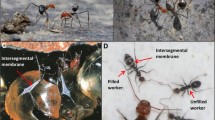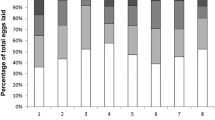Summary
There is high within-nest relatedness for functional queens (with corpora lutea), nonfunctional queens (without corpora lutea), and workers in polygynous nests of Leptothorax acervorum. The high functional queen relatedness suggests that young mated queens are adopted back to their mother nest. Functional queen relatedness does not change with the number of queens present in the nest, suggesting that the number of generations of queens, on average two to three, is rather stable. Worker relatedness decreases with increasing number of functional queens per nest (Tables 5, 6). The number of queens contributing offspring to the nest (mothers), estimated from worker and functional queen relatedness, is lower than the number of functional queens, particularly in highly polygynous nests. Estimates of number of mothers in monogynous nests indicate that these nests previously were polygynous (Table 7). There is no correlation between nest relatedness and distance between nests, and budding-off, if present, thus appears to be a rare mode of nest founding (Table 8). There are no indications of inbreeding in the two populations studied since the frequency of heterozygotes is as high as expected from random mating (Table 4). Most likely, polygyny is the rule in L. acervorum and serves to secure the presence of queens in the nest.
Similar content being viewed by others
References
Alloway TM, Buschinger A, Talbot M, Stuart R, Thomas C (1982) Polygyny and polydomy in three North American species of the ant genus (Leptothorax Mayr (Hymenoptera: Formicidae). Psyche 89:249–274
Buschinger A (1967) Verbreitung und Auswirkung von Mono- und Polygynie bei Arten der Gattung Leptothorax Mayr (Hymenoptera, Formicidae). Inaugural Dissertation, Würzburg
Buschinger A (1968) Mono- und Polygynie bei Arten der Gattung Leptothorax Mayr. Insectes Soc 15:217–225
Buschinger A (1974) Monogynie und Polygynie in Insektensozietäten. In: Schmidt GH (ed) Sozialpolymorphismus bei Insekten. Wissenschaftliche Verlagsgesellschaft, Stuttgart, pp 862–896
Craig R, Crozier RH (1978) No evidence for role of heterozygosity in ant caste determination. Isozyme Bull 11: 66–67
Crozier RH (1973) Apparent differential selection at an isozyme locus between queens and workers of the ant Aphaenogaster rudis. Genetics 73:313–318
Douwes P, Sivusaari L, Niklasson M, Stille B (1987) Relatedness among queens in polygynous nests of the ant Leptothorax acervorum. Genetica 75:23–29
Fabricius E (1952) Om felprestationer av instinkthandlingarnas medfödda utlösningsmekanism; (Mismatch between innate release mechanisms and instinct behaviours). Svensk Faunistisk Revy 14:10–17 (in Swedish)
Hamilton WD (1964) The genetical evolution of social behaviour I & II. J Theor Biol 7:1–52
Hamilton WD (1972) Altruism and related phenomena, mainly in social insects. Annu Rev Ecol Syst 3:193–232
Herbers JM (1986) Nest site limitation and facultative polygyny in the ant Leptothorax longispinosus. Behav Ecol Sociobiol 19:115–122
Nonacs P (1988) Queen number in colonies of social Hymenoptera as a kin selected adaption. Q Rev Biol 42:566–580
Pamilo P (1983) Genetic differentiation within subdivided populations of Formica ants. Evolution 37:1010–1022
Pamilo P, Varvio-Aho S-L (1979) Genetic structure of nests in the ant Formica sanguinea. Behav Ecol Sociobiol 6:91–98
Queller DC, Goodnight KF (1989) Estimating relatedness using genetic markers. Evolution 43:258–275
Queller DC, Strassmann JE, Hughes CR (1988) Genetic relatedness in colonies of tropical wasps with multiple queens. Science 242:1155–1157
Rosengreen R, Pamilo P (1983) The evolution of polygyny and polydomy in mound-building Formica ants. Acta Entomol Fennica 42:65–77
Ross KG (1988) Differential reproduction in multiple-queen colonies of the fire ant Solenopsis invicta (Hymenoptera: Formicidae). Behav Ecol Sociobiol 23:341–355
Selander RK, Smith MH, Yang SY, Johnson EE, Gentry JB (1971) Biochemical polymorphism and systematics in the genus Peromyscus. I. Variation in the old field mouse (Peromyscus polionotus). In: Genet 6 (Univ Texas Publ 7103), pp 49–90
Sokal RR, Rohlf FJ (1981) Biometry, 2nd edn. Freeman, Oxford
Sturtevant AH (1938) Essays on evolution. II. On the effect of selection on Social insects. Q Rev Biol 13:74–76
Williams GC, Williams DC (1957) Natural selection of individually harmful social adaptations among sibs with special reference to social insects. Evolution 11: 32–39
Wilson EO (1963) Social modifications related to rareness in ant species. Evolution 17:249–253
Wilson EO (1966) Behavior of social insects. Symp R Entomol Soc (Lond) 3:81–96
Wilson EO (1971) The insect societies. Harvard University Press, Cambridge
Wilson EO (1974) The population consequences of polygyny in the ant Leptothorax curvispinosus. Ann Entomol Soc Am 67:781–786
Author information
Authors and Affiliations
Rights and permissions
About this article
Cite this article
Stille, M., Stille, B. & Douwes, P. Polygyny, relatedness and nest founding in the polygynous myrmicine ant Leptothorax acervorum (Hymenoptera; Formicidae). Behav Ecol Sociobiol 28, 91–96 (1991). https://doi.org/10.1007/BF00180985
Received:
Accepted:
Issue Date:
DOI: https://doi.org/10.1007/BF00180985




